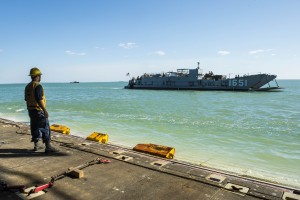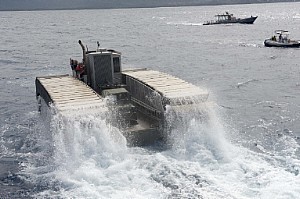 After more than twenty years of trying, America’s failure to recapitalize the humble Landing Craft, Utility, or LCU, is inexplicable.
After more than twenty years of trying, America’s failure to recapitalize the humble Landing Craft, Utility, or LCU, is inexplicable.
“Oh, but it’s really happening this time”, claim the learned observers. “Why,” they say, “today, we have an RFI out for a “NEW” LCU 1700 program, asking if shipbuilders can finalize a design (shudder) and build-to-print a NAVSEA-formulated vessel (yikes!), so it’ll start coming on-line by about 2020–when the humble LCU 1600 fleet is going to be about sixty years old (sigh).
Great. But do forgive me if I’m just not excited.
Like Bill Murray in his epic Groundhog Day movie, we’ve been here before. In 1999-2000 the LCU(R) was “really happening”, and monies were available for the project. But it all died in the aftermath of September 11. There might have been an LCU RFI in about 2007-8 (to be honest, there have been so many LCU RFIs over the years, that my memory is a bit hazy) that went nowhere. And back in 2012, the Surface Connector (X) was “really happening”, but it got buried under a welter of AoA alternatives after DoD released an RFI or two. I wrote about it back in 2013, saying:
It makes little sense for America’s gallant Marines to fight high-profile acquisition battles for big grey amphibious vessels (and force the re-introduction of a well deck into the big-deck amphibs, no less) while our antiquated LCU 1600 fleet–the poor bloody well-deck-dwelling infantry of amphibious warfare–crumbles into rust. A true amphibious warfare professional would be screaming for these cheap, flexible assets to get SLEPed or rebuilt. But nooo. Instead, the Marine Corps is dithering over the high-tech, tactical margins.
The 32-hull LCU 1600 fleet is in trouble. These basic landing craft–each capable of schlepping a good amount of gear to the beach–are simple, cheap and rugged. Their utility reaches beyond the beach. With a 10-day (or so) endurance, they can even conduct independent operations. As far as maintenance goes, their plant is relatively simple, and the LCU crew can do a lot (a lot on their own) to keep the landing craft operation. But the fleet’s age averages in at about 42 years, and repairs of repairs of repairs are finally breaking down for good. As the venerable platforms grow increasingly feeble, their rated max cargo load is declining and their availability is slumping.
On the procurement front, LCUs have been ignored. Folks talk (and talk and talk) about replacing the LCU fleet. It is a conversation that has been going on for….more than a decade now. And despite all the talk about how the LCU replacement is “just around the corner”, nothing seems to happen. A simple design refresh would be easy to do. But you can sense what the procurement warriors want–a complex and power-dense device or some grand-feat-of-engineering contraption.
Community enthusiasm for Surface Connector (X) expired as various parties fought for high-tech/new-tech alternatives–a crazy swimming tractor (the UHAC), super-fast air cushions, folding wonders (LCU-F), speedy on-plane-capable aluminum variants, and so forth.
It was all very “exciting” stuff, wild-eyed Marine Corps Warfighting Lab-inspired craziness, imbued with that dated “Marines are gonna land on the Kola Peninsula “Operational Maneuver From The Sea” ethos”. But, thankfully, none if it took.
It now looks that (assuming America really will replace this unsexy platform!!) the Navy is going to seek little more than a refresh of the legacy design. And that’s great! There is no need to push the design envelope on what is, at heart, a simple, logistical-minded craft (let’s acknowledge that physics exists and that a beachable, flat-bottomed craft is governed by it). By all means, refresh the craft (add LED lighting, better engines, a stronger ramp, and maybe some bare-bones electronics/integration gear), but retain the basic beefy, keep-it-simple-stupid focus.
Despite all the OMFTS-minded gnashing-of-teeth and rending-of-garments over the prospect of spending thirty more years with a lumbering LCU, the LCU is too useful to not build. At the LCU’s most fundamental–albeit most uncreative–beach-to-ship logistics role (let’s face it, even though LCUs can only beach on a very small proportion of the world’s beaches, they’re still bloody useful), these platforms are, essentially, the effector arm of America’s Amphibious Fleet. Every time these venerable landing craft fail, then their host amphib (a two-billion plus capital investment) is unable to project (e.g., sustain) meaningful power ashore.
But that’s not all–it never was “just about the beach” for the humble LCU. The LCU serves (or has the potential to serve) in a number of very interesting roles outside of the beachhead support role–and these are the reasons why we need the LCU.
Don’t take my word for it. Take Jay D. Bottelson’s excellent 2001 Thesis, “Landing Craft Utility as a Force Multiplier in the Littorals“, from the Marine Corps University. He identified several missions suitable (or already being undertaken) for/by LCUs, including:
- Choke Point Monitoring/Surveillance
- Clandestine Boat Operations
- Communications Relay Platform
- Crypto/Signals Intelligence/Electronic Support Platform
- Deception Van Platform
- Force Protection Operations
- General/Utility Support
- Humanitarian Assistance Operations
- Maritime Interception Operations
- MPF Offload/Transfer
- Mine Warfare Support Platform
- Port Opening/Salvage Operations
- Riverine Operations
That’s an interesting list, no?
Add in some bolt-on modular strike assets or shallow water ASW…something…and then maybe even Vice Admiral Thomas “Distributed Lethality” Rowden might get interested in these lumbering, flat-bottomed sea slugs.
 In my mind, old-fashioned, refreshed LCUs are cheap enough, simple enough, and useful enough to be built at a sustainable rate, for a good long time. Forget the superfast block-build baloney (“hey, let’s build them all before anybody realizes there’s a fundamental design flaw and before DOT&E tries to kill it!”), and build these things at a rate of two or so a year, forever, flowing incremental improvements into the design (Yeah, yeah, I know that’ll never happen, but hey, I’m an optimist!).
In my mind, old-fashioned, refreshed LCUs are cheap enough, simple enough, and useful enough to be built at a sustainable rate, for a good long time. Forget the superfast block-build baloney (“hey, let’s build them all before anybody realizes there’s a fundamental design flaw and before DOT&E tries to kill it!”), and build these things at a rate of two or so a year, forever, flowing incremental improvements into the design (Yeah, yeah, I know that’ll never happen, but hey, I’m an optimist!).
Now, all this talk about the wonderful old-school LCU isn’t to say that I am against interesting kit like the transformable and speedy L-CAT. There is plenty of room in the LCU mission-space for fun, high-tech items. In particular, I think the Army’s LCU-replacement program, the MSV(L), offers/offered (at least in the RFI stage) a potential on-ramp for some of the high-tech entrants into the LCU field, and the L-CAT might be a perfect fit. The Army isn’t going aboard L-class amphibs, but it still needs things to move equipment about the vast Pacific. So, to me, a bigger LCAT (with some extra habitability and defense capabilities) might be a neat choice. I certainly wish that the Army and Navy were working more closely on these programs so they could collect some logistical benefits (parts commonality, shared well-deck utility, Seabase integration, etc.,), but…inter-service rivalry is a Pentagon Constant. And that’s a story for another post.


{ 1 comment… read it below or add one }
Glad to see NextNavy publishing again. It seems like next generation LCU planning has been a slave to multiple variables that have taken too long to resolve: the AAV/EFV/ACV handwringing and how it disrupts the OTH dream; the future of air cushioned SSCs; whether to have well decks on America Class LHDs; the next-gen LPD; even amphib aviation issues are affecting ship size, therefore well deck dimensions, therefore LCU design.
.
These variables and such inconsistent well decks only confuse and delay decision making. Had the US Navy been ‘stuck’ for decades with consistent well decks on all classes, that constraint would have probably resulted in a more focused and speedy LCU development program.
.
I agree with retaining the lumbering utility of an open-top LCU, but would like to see a hybrid of the LCU and the speedy folding LCU-F. That is, take the LCU-F concept, remove the roof and its missile and cannon, skip the helo pad idea, and finally make the folding elements removable. The folding planing hull provides OTH range for amphibious assault, while a ‘naked’ LCU-F can perform inshore utility functions like disaster assistance without the folding elements getting in the way. Maybe this trimmed down idea can also resolve the LCU-Fs main shortcoming — it must pivot outside the surf zone and hit the beach backward to debark vehicles. Fix that and it’s gold. Six of them fit in a Whidbey Class LSD; gotta love those ergonomics.